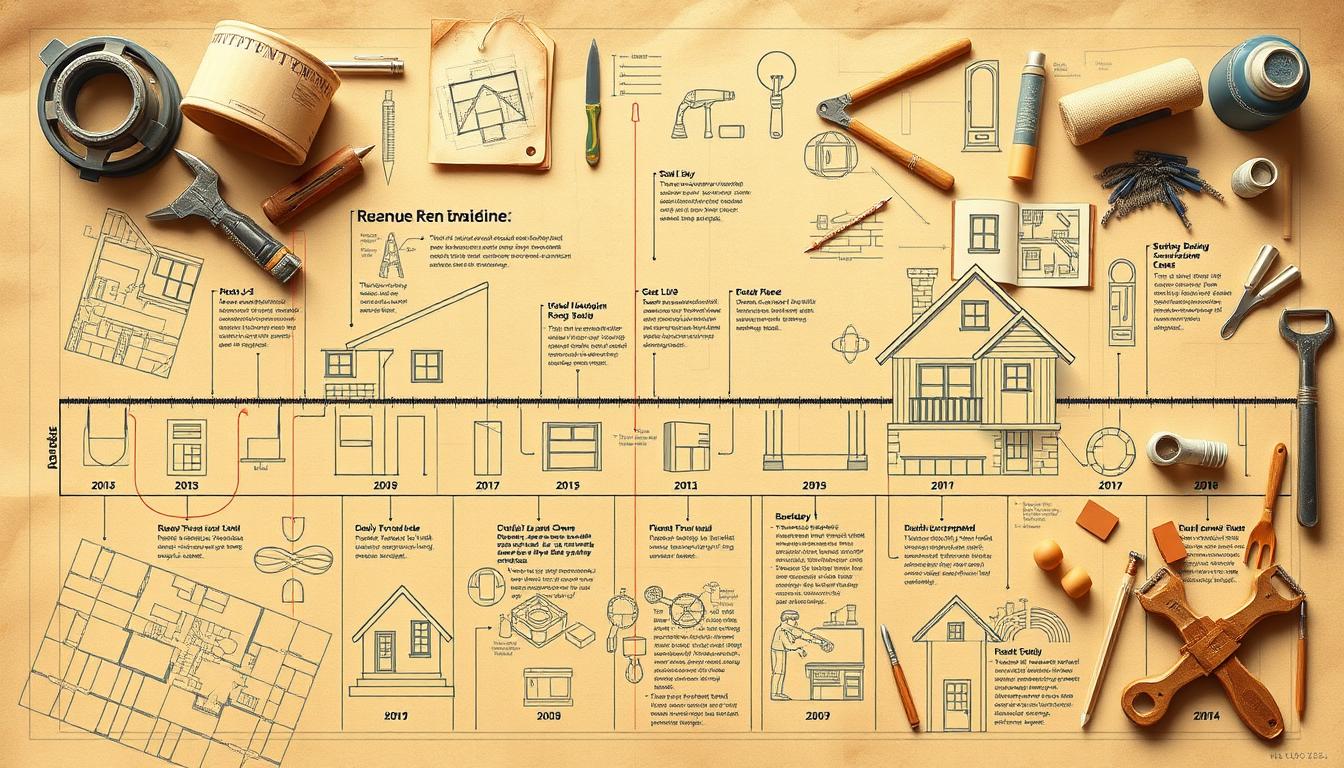
Starting a project to enhance your living area may be a lot of fun, but you may also feel overwhelmed at times. A strong home renovation timeline is a must, to keep everything right on track. Planning poorly could mean that delays and unplanned costs start piling up.
By creating a detailed timetable you can manage contractors and materials better. It is also a way to ensure that every stage, from design to construction, goes continuously. Note taking along the way can be a very helpful tool to keep you in order and within your budget.
This guide will accompany you through every part of the project. Watching this video, you will gain practical tips to avoid regularly encountered problems, so you can keep your plan a pace. This article contains everything you need, whether you decide to collaborate with a contractor or carry out the work by yourself.
Key Takeaways
- A transparent plan eliminates the risk of delays and extra costs.
- Good preparation is the way to handle contractors and materials.
- Recording notes is the way to stay organized and maintain a budget.
- Every stage, whether in the design or construction phase, should be scheduled correctly.
- This guide offers specific tips for every step of the project.
Introduction: Laying the Foundation for Your Renovation
All excellent projects come from a sound plan, and improving the home is no exception. A good plan with thorough preparation will help you make your idea a reality without the stress or delays.
Start by collecting rough estimates for the work that you want to carry out. This step will help in understanding the costs involved as well as prioritizing the tasks effectively. Creating a priority list at the beginning will save you time and costs later on.
Recognizing the size of your project is just as significant. Whether you are enhancing a floor, adding a wall, or revising the whole area, having an idea of what is involved is key to keeping the operation on the rail.
Do not disregard the requirement for permits. Depending on the construction and modifications you are making, it is necessary to obtain prior approval from local regulations. Early approval will prevent any costly interruptions in the future.
This initial phase is the footing part of the establishment for the entire schedule. With a strong base, you shall have overall smoother stage transfers and better workflow.
Understanding the Importance of a Home Renovation Timeline
Running a remodeling project is about more than just ideas—it is a precision game. A meticulous timeline is your best aid to make every step of the process go along smoothly. Without it, even the most straightforward tasks can produce a chain of unexpected delays and incurred costs.
What is the need for a timeline? It prepares you for crises, such as: wrong writs, leaky pipes, or scheduling conflicts among trades. Segmenting the project into several distinct phases simplifies the task and enhances communication. For instance, one homeowner sidestepped a ton of troubles by rescheduling inspections beforehand, thus ensuring no surprises during the build.
Why a Detailed Timeline Matters
An explicit scheme is an essential means for your contractor to eliminate miscommunication and ensure the timely arrival of materials. It also allows to make sure the absence of overlooking key tasks. For example, a family managed to save several thousand by finding out about plumbing issues before it required expensive repairs.
Common Pitfalls and How to Avoid Them
Delays and miscommunications often occur in remodeling. Here is how to sidestep them:
- Plan for flexibility: Include extra time in your schedule to deal with unanticipated problems.
- Communicate clearly: Hold regular meetings with your team to sort out problems before they get worse.
- Prioritize tasks
By following a comprehensive plan, you can turn a chaotic remodel into a front-to-back easy process. Don’t forget planning is the main factor for the success of your project.
Budgeting and Financial Planning for Your Remodel
The efficient management of funds is the foundation of a successful remodel. A definite budget is the best assurance that you can cover any phase of the project without overspending. If the plan is not well laid, surprise costs can halt your progress.
Begin by estimating the total cost for your remodel. Sort it into categories such as labor, materials, and permits. This process assists you in setting priorities and distributing funds rationally. For instance, labor is commonly budgeted up to 30-40% and materials to 40-50%.
Allocating Funds for Labor, Materials, and Surprises
Labor and materials are the two principal expenditures in any remodel. Employing qualified people indicates good quality work, but it also costs more. Contractors quote from $50 to $100 an hour, depending on how complex it is.
Material prices are impacted greatly by your choices. For example, standalone cabinets start from $500 to $1,200 per linear foot, while stock options are cheaper. Don’t forget to account for this when ordering to prevent delays.
Unplanned surprises are bound to arise. For example, faulty wiring or a concealed plumbing issue may come to light and these can raise your costs. Proportioning 10-20% of your budget for surprise issues makes sure you are ready for anything.
Building a Contingency Budget
A contingency budget is your safety rope in the course of a remodel. It comes into play when there are unforeseen emergencies like structural repairs or last-minute design changes. Without it, the project might be halted, or you have to take on debt.
A typical budget configuration may look this way:
| Category | Percentage of Budget |
|---|---|
| Labor | 30-40% |
| Materials | 40-50% |
| Contingency | 10-20% |
Smart financial planning will keep your project on the right path and, in addition, increase your home equity. Being under a realistic budget guarantees your smooth remodel and creates a more valuable property.
Defining the Scope and Phases of Your Renovation
Defining the scope of your project is the first thing on the path to a changing project. It gives you the chance to identify key objectives and organize tasks time wisely. In the absence of a well-articulated plan, even the simplest projects can appear to be monumental.
Start by finding out your core concerns. Are you fixing a bathroom, adding a new wall, or reinterpreting the whole space? Being aware of your priorities means the logistics will never be out of sync.
Establishing Project Priorities and Permits
Securing the necessary permits is the next step once you’ve defined your scope. Local regulations usually ask for the approval of any structural alterations or major updates. Ignoring such a step could result in very expensive delays or fines.
Here’s a short plan that will assist in keeping you organized:
- Check the local building codes and requirements.
- Submit the permit applications before the due date to avoid delays.
- Store all the papers in one folder for quick data access.
Paragraph of the Renovation Process
Dividing your project into understandable phases guarantees all the processes are done in the right order. Even from the first phase of demolition to the last step of finishing details, each process is integral in the general success of your build.
Here’s the typical breakdown of phases:
| Phase | Description |
|---|---|
| Planning | Define the objective, set the budget, and secure the approvals. |
| Demolition | Eliminate old structures or items. |
| Construction | Build new structures or do structural modifications. |
| Finishing | Install the fixtures, paint, and put the last few things. |
By putting your project into specific phases, you will keep the whole schedule on time. This methodology is less disruptive and produces an overall smoother experience.
Preparing for Demolition and Structural Changes
The demolition phase is general the most changing part of any project. This is when the old items are replaced with new ones. But this stage may also uncover hidden problems that are urgent for correction. Good preparation lays a pathway to a fast-forward transition to the next steps.
https://www.youtube.com/watch?v=emDbC5T9chA&pp=sAQA
Before the kickoff, examine the house’s present state. This review pinpoints potential complications such as worn wiring or loose walls. Overlooking this inspection can end up costing you a small fortune afterward.
Steps for Safe Removal and Preparation
Demolition is not about just destroying the building. It’s about doing it in a safe and effective way. Start by tearing off fixtures and appliances and plan to relocate them to protect them from damage. Then, continue with structural things such as walls and floors. Remember to put on always protective equipment and abide by safety regulations.
Look at the following list to guide you:
- Handle off utilities such as plumbing and power.
- Clear the space of furniture and personal belongings.
- Use good tools to prevent extra damage.
Scheduling and Avoiding Delays
Time is of the essence during demolition. Setting up this stage at the beginning will help avoid subsequent delays. For instance, one homeowner sidestepped a big disadvantage just by checking with their contractor to make sure materials were delivered on time. Planning properly is what holds the project together.
Common surprises during demolition encage hidden mold, wrong wiring, or structural decay. Fixing these things on time will result in a standardized build process.
Through thorough preparation, you will lay down a solid base for a successful construction phase. Keep in mind that demolition is a mere starter-up of the taxi ride through out misfortunes but it is crucial.
Coordinating Electrical, Plumbing, and Mechanical Work
Coordinating electrical, plumbing, and mechanical work is a vital step in a building operation. This phase is where the installation of all the systems occurs before the walls and finishes are applied. If this portion is not done right, it can lead to expensive rework later on.
In order to coordinate the work of electricians, plumbers, and other trades, one has to have accurate scheduling. Every task has to be performed in the right order to avoid delays. For example, after the insulation is added, electrical wiring should be done before it.
Scheduling First Fixes with Sub-Contractors
The first fix phase is where the main components such as wired, pipes, and ductwork are installed. It is the initial action that determines the direction of the whole project. If wrong actions happen in this step, significant drawbacks can occur later on.
This phase has some best practices:
- Contractor and sub-contractors should communicate very clearly.
- Prepare a schedule containing all tasks and deadlines.
- Allow time for things that come up, for example: hidden structural problems.
Ensuring Compliance with Building Codes
Local building codes are strict. These regulations are the best way to maintain safety and quality in every build. Bypassing this step could lead to penalties or even project halts.
Here’s how to maintain compliance:
| Step | Description |
|---|---|
| Research | Get familiar with local codes and requirements. |
| Permits | Before starting the work, you must get the necessary approvals. |
| Inspections | Organize inspections at relevant times. |
These steps will help you avoid expensive mistakes and will ensure your project meets all guidelines.
Coordinating different fields of work and being compliance may give you the impression of being burdensome, but it is doable with careful planning. Use this guide to keep the schedule on track and your build within budget.
Interior Finishing and Design Updates Execution
The final stages of your project see your vision turning into reality with spectacular results. This is the time when your space is transformed entirely, functionality being combined with aesthetic look. Every detail, from putting up cabinets to refreshing lighting, is significant.
The first station can be kitchen, often the heart of the home, actually. Installing cabinets calls for a careful installation to ensure they are perfectly aligned with your design plan. “Measure twice, cut once,” is a phrase that goes here in terms of caution. Correct positioning prevents the jamming of the cabinet operations and gives the area a neat appearance.
Lighting is another vital step. The fixtures you will choose must be related to your space and at the same time they must allow sufficient light. For example, pendant lamps above the kitchen island add to the style and functionality. The scheduling of the lighting ought to be done after the electrical work is finished as this is the right technique.
To save time, all the decorative and construction phases should be coordinated beforehand. For instance, painting should only be done after the drywall has been installed and sanded. This ensures a flawless surface without the need for redo.
Here are some tricks to make the process faster:
- Planning for the future: Create a step-by-step checklist before starting.
- Effective communication: Keep your team posted about schedules and expectations.
- Task prioritization: Finish essential upgrades first so as to keep the project on track.
Meticulous execution draws out every idea perfectly. Following these guidelines, you will create a space that is beautiful and functional at the same time.
Effectively Managing Delays and Solving Renovation Issues
Delays are an accident that happens in every remodeling process, but with the right techniques, they can be handled very well. It does not matter whether it is shortage of material or the sudden appearance of structural issues, setbacks can ruin your timeline. The solution to this is flexibility and proactivity.
Frequent reasons for delays include weather, supply chain issues, and unexpected costs. For instance, a homeowner who had a flooring material on back order was delayed by two weeks. They managed to do this by having an alternative plan that minimized the effect on their schedule.
Ways to Reschedule Work
Shifting your timeline doesn’t mean you have to derail your entire project. You can start by locating tasks that can be shifted without any impact on the overall process. For example, sometimes, painting can be arranged later if construction is delayed.
Here are some methods for rescheduling effectively:
- Prioritize tasks: Concentrate on critical steps first to ensure the build continues.
- Communicate clearly: Keep your contractor and team informed about changes.
- Plan for flexibility: Allocate extra time in your schedule to counter unforeseen challenges.
Risk Management and Flexibility Suggestions
Risk management is practically your lifeline to the effective project implementation. Starting by pointing out what might go wrong early in the process is a good path. For instance, if you are updating an older house, prepare for electrical or plumbing problems.
Take the steps below to manage odds effectively:
- Set aside a contingency budget: Set 10-20% of your total cost for any expenses that may emerge.
- Stay organized: Collect permits, contracts, and design plans in one folder.
- Make sure everyone is aligned: Frequent check-ins with your team can assure everyone is on track.
Being prepared and flexible gives you the power to face any obstacle, no matter what. Bear in mind, that the timeline is the crux of the model that is well managed.
Communication with Contractors and Teams That Works
Communication is the lifeblood of any home remodeling and, of course, it has to be effective too. Having everybody on the same track is what makes the process smooth and consequently reduces delays. You may be dealing with a contractor or be the one managing the team, in either case, clear updates and open discussions are the essentials.
Current-day tools such as project management applications and chatting portals are now so fast we don’t have to worry about mishaps in processing real-time updates. These aids make your monitoring easier, allow you to ideas, and clarify any doubts at a rapid pace.
Using Technology for Timely Updates
Apps solving problems such as Trello or Asana can enhance your scheduling. These platforms allow you to assign tasks, set deadlines, and monitor each phase of the build. Regular check-ins via video calls or group meetings keep everyone aligned and informed.
Here are some tips for efficient communication:
- Set regular meetings: Weekly updates ensure everyone stays on track.
- Be proactive: Discuss changes or concerns as soon as they arise.
- Use visuals: Share photos or sketches to clarify your ideas.
By remaining organized and being the first to act, you will quickly sort out issues ensuring your timeline is whole. Plain communication is hence, the spine of a remodeled system.
Book of Tricks
Although the idea of a renovation project seems daunting, in reality, it is completely under your control if you choose the right methods. A comprehensively processed build commences right from a clear timeline and budget. These instruments will see you through and help you avoid any unpleasant surprises.
From the first phase of knocking down walls to the last few touches, everything step has its important place. Whether you are adding a new bathroom or remodeling a wall, the painstaking planning brings about the success of every little step. Having smooth communication with your colleagues and being adaptable are the primary solutions of working through difficulties.
Each homeowner is able to properly carry out their project by adhering to the steps in this guide. These hints will help you ensure that your house renovation goes through without any hassle. With the correct groundwork, you will actualize your idea through avoiding tension.


